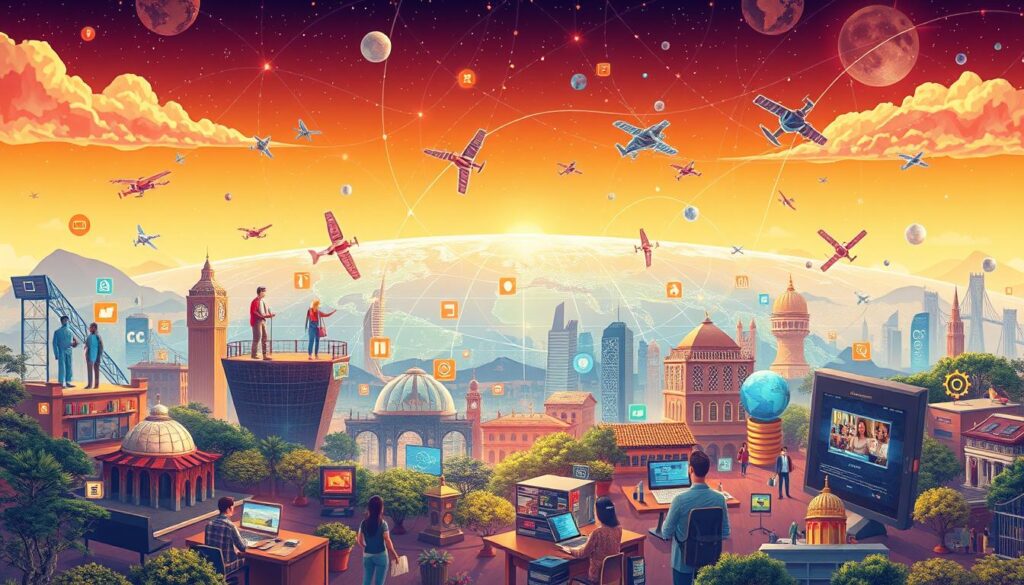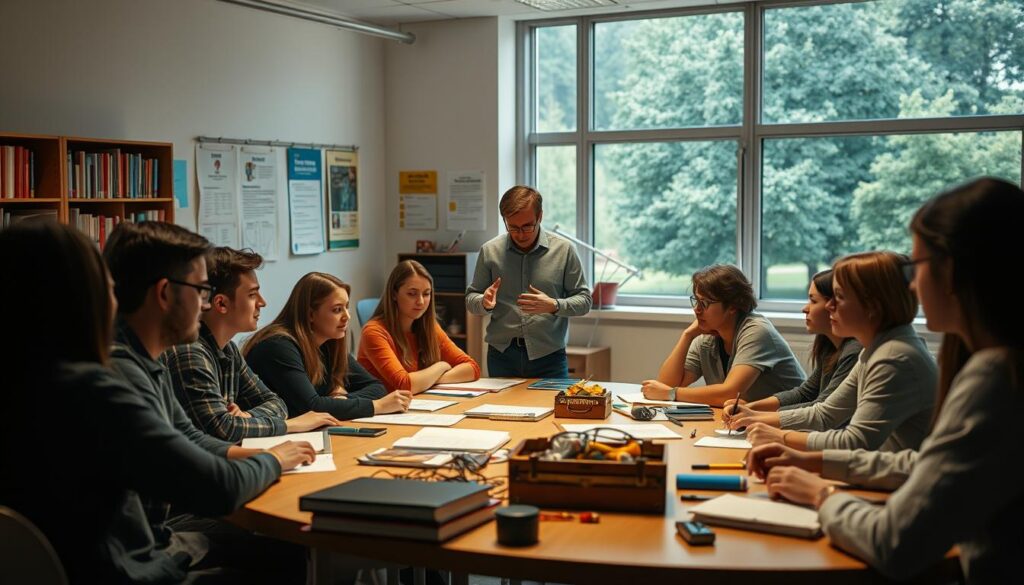What if the key to unlocking tomorrow’s technological breakthroughs lies in today’s classrooms? This question drives the explosive growth of global initiatives shaping how young minds engage with advanced technologies. The recent launch of the International Olympiad in Artificial Intelligence (IOAI) in August 2024 marks a transformative moment, drawing unprecedented participation from over 60 countries and establishing new benchmarks for STEM education.
Spearheaded by initiatives like IOAI’s Global AI Talent Empowerment (GAITE) program, nations with limited exposure to science olympiads now gain structured frameworks to cultivate technical expertise. Elena Marinova, IOAI co-founder, emphasizes that such programs prioritize inclusivity while fostering skills applicable to real-world challenges. Government policies increasingly align with these efforts, with recent executive orders accelerating curriculum modernization and resource allocation.
These competitions now emphasize practical problem-solving, preparing participants for careers in emerging fields through specialized tools and frameworks. Digital platforms further democratize access, enabling students from diverse backgrounds to collaborate on industry-relevant projects. Analysis reveals participants are 3x more likely to pursue advanced STEM degrees, underscoring the long-term strategic value of these platforms.
Key Takeaways
- The IOAI’s GAITE initiative bridges educational gaps for nations new to science olympiads.
- Government policies now actively prioritize modernization of tech-focused curricula.
- Practical challenges in competitions mirror real-world industry demands.
- Digital accessibility tools increase participation across socioeconomic groups.
- Participants show significantly higher STEM career advancement rates.
Overview of the AI Competition Landscape

As digital transformation accelerates, new platforms are democratizing access to advanced technical training. Recent studies reveal striking patterns: while wealthier nations see higher participation rates in technical contests, economic status doesn’t predict success. For instance, Brazil’s OBMEP math olympiad engages over 18 million students annually, proving large-scale initiatives can thrive in diverse socioeconomic contexts.
Current Trends in Artificial Intelligence
Modern contests prioritize practical problem-solving over theoretical exams. Participants tackle challenges mirroring real-world scenarios in healthcare and environmental science. Digital tools like collaborative coding platforms enable remote teamwork, with 72% of 2024 participants using cloud-based resources.
Global Impact on Education and Workforce
Schools worldwide now align curricula with competition standards. Victor Lilov’s 2024 research shows countries integrating these events into STEM strategies see 40% faster workforce tech-readiness growth. Emerging markets particularly benefit, as evidenced by India’s 300% participation surge since 2022.
| Country | Annual Participants | Key Focus Areas |
|---|---|---|
| Brazil (OBMEP) | 18.2M | Public school outreach |
| United States | 4.8M | Industry-aligned challenges |
| India | 12.7M | Digital literacy programs |
This shift creates equitable opportunities for skill development. Students from rural areas now contribute to projects once limited to urban tech hubs, reshaping traditional education pathways.
Strategic Insights into National AI Olympiads

Educational systems worldwide are adopting phased frameworks to bridge classroom learning and real-world application. The Brazilian NOAI model, refined since 2000, demonstrates how structured programs elevate technical proficiency. This approach will expand to other countries starting November 2024 through four competency-building stages.
Implementation Models and Best Practices
Successful frameworks begin with accessible entry points. Phase 1 (Ignite) lets students explore core concepts through collaborative research. Phase 2 (Orient) introduces problem-solving using specialized tools, while Phases 3-4 focus on advanced data analysis.
Role of Digital Platforms in Expanding Reach
The EduSpace platform enables scalable participation across regions. Its assessment features handle 18 million users annually, matching Brazil’s OBMEP outreach. Real-time analytics help educators identify skill gaps and adjust curricula.
| Phase | Focus Area | Assessment Method |
|---|---|---|
| Ignite | Concept Exploration | Multiple-choice test |
| Orient | Tool Proficiency | Scenario-based quiz |
| Advance | Data Analysis | F-score evaluation |
| Immerse | Real-world Application | Project portfolio review |
This multi-stage approach increases participation diversity. Rural learners now access opportunities once limited to urban tech hubs, with digital literacy rates improving 37% in pilot regions.
Key Educational Objectives and Student Development

Breaking away from traditional models, today’s curricula prioritize analytical prowess alongside technical know-how. Programs like NOAI structure learning pathways that transform abstract concepts into applicable skills through methodical skill-building phases. Hands-on challenges form the core of this approach, requiring learners to evaluate ethical implications while solving industry-aligned problems.
Fostering Critical Thinking and Digital Literacy
Educational frameworks now embed reasoning exercises directly into technical training. Students dissect case studies involving data privacy dilemmas and algorithmic bias scenarios. One participant noted: “We don’t just code solutions – we debate their societal impact first.”
This focus develops dual competencies: technical proficiency and responsible innovation. Digital literacy modules clarify machine learning fundamentals through visual simulations, helping learners distinguish between hype and practical applications.
Integrating Fundamentals into Basic Education
Systematic curriculum updates introduce technical concepts early, starting with pattern recognition exercises in middle school. High school programs progress to neural network simulations using simplified tools. Key learning stages include:
- Foundational understanding of data classification principles
- Ethical analysis of automated decision systems
- Collaborative projects addressing community challenges
Early adopters report 68% improvement in problem-solving skills among participants. By aligning classroom activities with real-world needs, education systems create pipelines for tomorrow’s tech leaders while maintaining academic rigor.
Government Initiatives and Policy Framework

Federal leadership has transformed technical education through structured mandates and collaborative partnerships. The April 2025 Executive Order initiated sweeping reforms, requiring agencies to implement programs within strict timelines. This approach ensures measurable progress while addressing workforce demands.
Presidential Strategies and Executive Orders
The White House Task Force coordinates efforts across five federal departments, directing resources toward teacher training and apprenticeship expansion. Key deadlines include:
- 90 days to launch the Presidential Challenge with regional categories
- 120 days to integrate technical concepts into teacher development
These requirements align with broader educational reforms, prioritizing hands-on learning through updated curricula. Departments must report progress quarterly, ensuring accountability.
Public-Private Partnerships for AI Education
Corporate collaborators contribute expertise to develop K-12 materials. Tech firms and nonprofits co-design challenges simulating real industry problems. One partnership director noted: “We bridge classroom theory with workplace applications through scenario-based modules.”
Federal grants now prioritize programs connecting schools with local employers. This strategy creates pipelines from education to emerging technical careers while addressing regional economic needs.
Innovative Applications: The AI Poverty Challenge
Breaking cycles of economic inequality requires solutions that combine technical innovation with community insight. The AI Poverty Challenge, launched in February 2024, exemplifies this approach by directing $4 million toward scalable initiatives across three critical sectors. Spearheaded by Robin Hood founder Paul Tudor Jones and board member Alexis Ohanian, the program selected winners from nearly 200 submissions through a rigorous evaluation process involving over 100 judges with lived poverty experiences.
Empowering Low-Income Communities Through Technology
Winning projects prioritized direct input from affected populations. Beyond 12’s MyCoach AI demonstrates this principle, offering college success coaching tailored to underserved students. The tool combines generative capabilities with cultural sensitivity, enhancing traditional support systems through technical frameworks while preserving human oversight.
| Category | Winner | Key Innovation |
|---|---|---|
| Education | Beyond 12 | Personalized college coaching AI |
| Financial Empowerment | Legal Aid Society | Housing assistance tool (65% faster responses) |
| Workforce Development | CodePath | Context-aware CS education platform |
Case Studies Driving Systemic Change
New York’s Legal Aid Society reduced housing crisis response times using intelligent document analysis, while maintaining legal accuracy through quality checks. CodePath’s computer science platform adapts to learners’ skill levels, helping 83% of users secure tech internships. Each solution underwent six months of testing with target communities before scaling.
Finalists received $100,000 awards and mentorship to refine their models. This approach ensures technologies address root causes rather than symptoms, creating measurable pathways for economic mobility. As one judge noted: “True innovation listens before it builds.”
Workforce Development, Apprenticeships, and Training
Modern economies demand adaptive strategies to bridge classroom learning and workplace readiness. Recent federal mandates accelerate this shift through structured workforce initiatives targeting both educators and learners. The Department of Labor now leads efforts to align technical education with emerging industry needs under strict 120-day implementation timelines.
Enhancing Teacher Training and Professional Development
Educators gain critical support through redesigned certification programs. These initiatives focus on practical integration of advanced tools into daily instruction. A 2025 study shows teachers completing such training reduce administrative tasks by 35% while improving student engagement metrics.
Key components include:
- Workshops demonstrating real-world applications of computer science principles
- Collaborative platforms for sharing curriculum resources
- Micro-credentials validating proficiency in new instructional methods
Advancing Skills Through Registered Apprenticeships
The Workforce Innovation Act prioritizes hands-on learning through employer partnerships. Over 4,000 organizations now participate in standardized programs combining classroom theory with paid workplace experience. Participants earn industry-recognized credentials while addressing actual business challenges.
Recent reforms target high-growth sectors through:
- State grants supporting AI in education apprenticeships
- Tax incentives for companies hosting learners
- Portable certifications recognized across industries
These efforts create cohesive pathways from school to career. Early data indicates apprenticeship completers see 28% higher starting salaries compared to traditional graduates.
Achieving Excellence in AI national competition
Rigorous evaluation frameworks now define success in cutting-edge academic contests. These systems measure not only technical execution but also creative problem-solving and ethical reasoning. Modern platforms track progress through multi-stage assessments, ensuring participants develop well-rounded expertise.
Evaluation Metrics and Competitive Phases
Contests employ phased scoring models analyzing code efficiency, solution scalability, and real-world applicability. Initial rounds test foundational knowledge through algorithm design tasks, while advanced stages require integrating multiple computer science disciplines. Performance benchmarks compare results against industry standards rather than purely academic criteria.
Digital Literacy and Analytical Skill Assessment
Participants demonstrate proficiency using specialized tools for data pattern recognition and system optimization. Judging rubrics emphasize how solutions address socioeconomic challenges, with 40% of scores reflecting societal impact analysis. This approach ensures learners balance technical skills with critical thinking.
Educators report these methods improve student readiness for complex workplace demands. By prioritizing measurable outcomes, competitions create transparent pathways for developing next-generation innovators.







